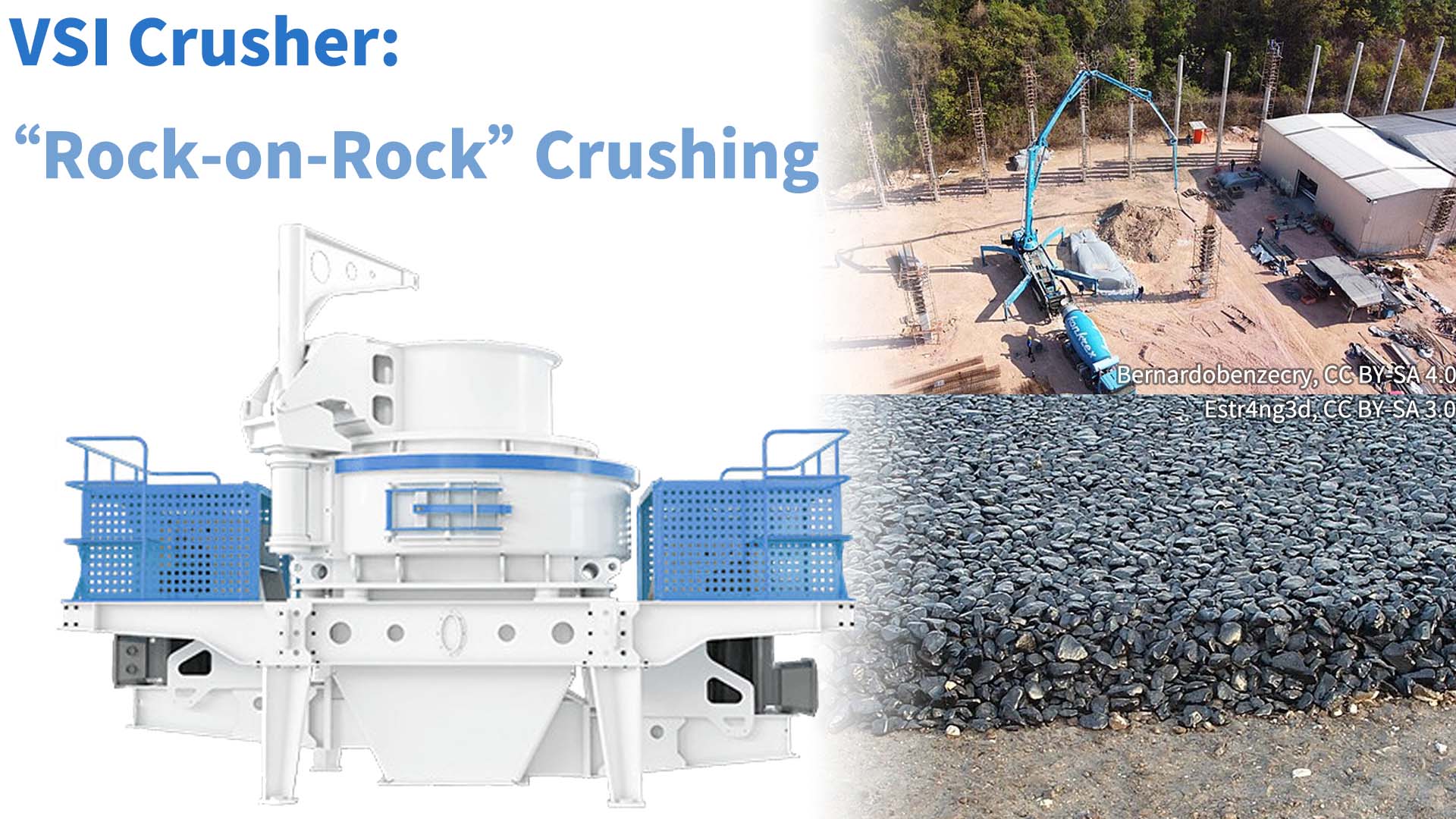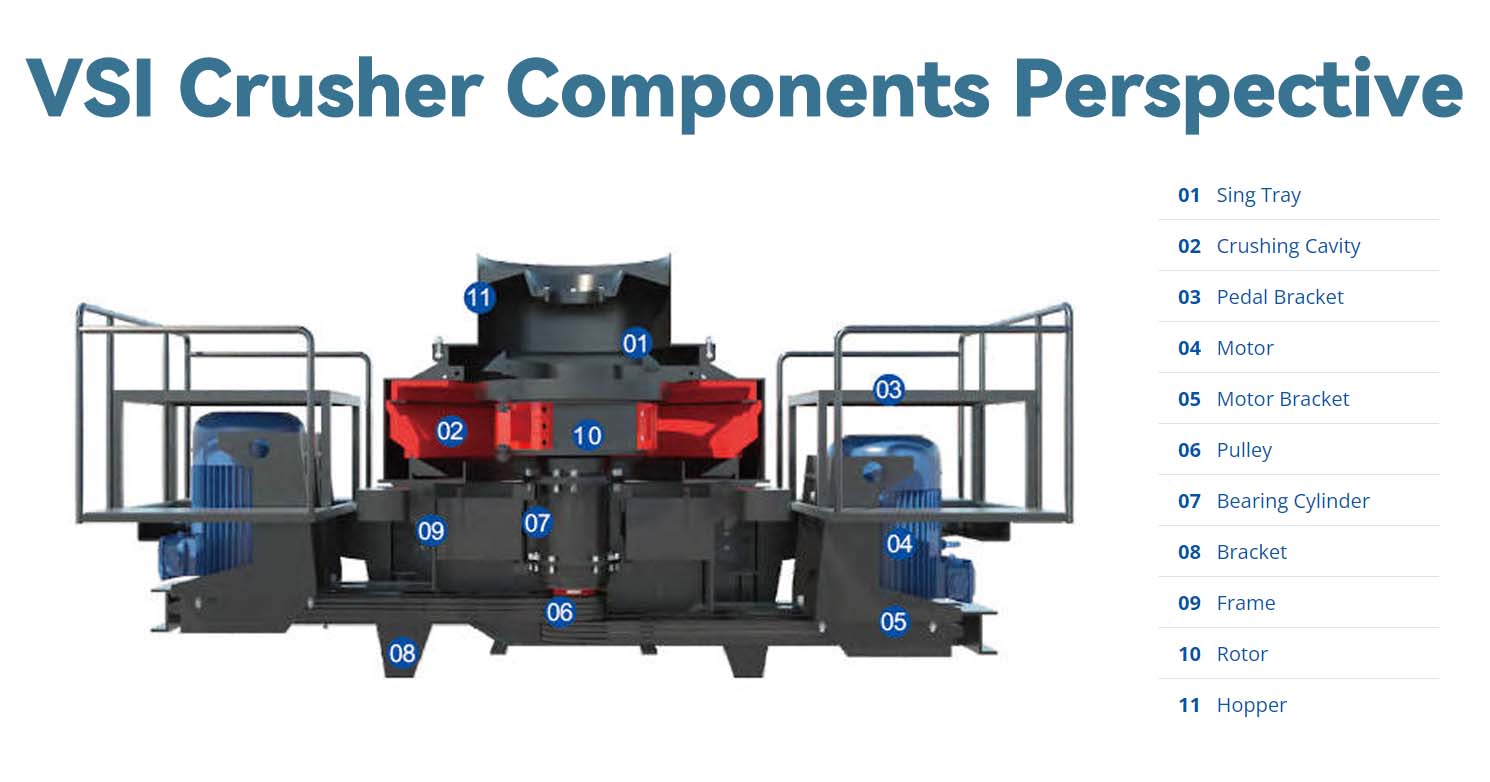VSI (Vertical Shaft Impactor) crusher operate on a unique rock-breaking philosophy where materials are crushed through high-speed collisions rather than traditional compression. At the heart of the system is a vertically mounted rotor that accelerates rocks to extreme velocities - typically 45-70 m/s - before projecting them outward into a precisely shaped crushing chamber. This creates a controlled cascade where particles fracture upon impacting either other rocks or specially designed anvil surfaces, transforming large feed material into perfectly shaped aggregates or manufactured sand.

What makes this mechanism revolutionary is its energy efficiency and particle shaping capability. Unlike conventional crushers that rely on metal-to-rock compression causing rapid wear, the VSI's "stone-on-stone" crushing ensures that most impact occurs between rocks themselves. The result is not just reduced maintenance costs from less metal wear, but also superior product cubicity crucial for high-grade concrete production and asphalt mixtures where angular particle shapes enhance binding strength.
The rock-on-rock crushing mechanism represents a paradigm shift in comminution technology. When feed material enters the spinning rotor, centrifugal force propels particles outward through rotor channels, accelerating them to terminal velocity before ejection. These projectiles then collide either with the rock bed formed by previously crushed material (autogenous crushing) or with strategically positioned anvils (semi-autogenous crushing). This dual-impact approach ensures thorough size reduction while minimizing direct contact between metal components and abrasive materials.

In practical operation, this translates to dramatic improvements in wear part longevity. Traditional crushers might require liner replacements every few hundred hours, whereas VSI crushers can operate for thousands of hours between maintenance intervals. The reduced metal-to-rock contact also lowers contamination risks in sensitive applications like glass sand production or high-purity industrial minerals where even trace metal impurities could compromise product quality.
The centrifugal rotor forms the dynamic core of every VSI system, engineered with precisely angled discharge ports that determine material trajectory and impact energy. Modern rotors feature segmented designs allowing quick replacement of wear parts without dismantling the entire assembly. Complementing this is the feed hopper's hydrodynamically optimized geometry that ensures smooth material flow into the rotor at optimal angles, preventing blockages while maintaining consistent feed rates essential for uniform product gradation.
Downstream from the rotor, adjustable anvils or impact plates serve as the final particle-shaping stations. These strategically positioned surfaces can be finely tuned during operation to control product size distribution, typically producing 0-5mm fine sand ideal for construction applications. Some advanced models incorporate cascade systems where material undergoes multiple impact stages within a single pass through the crusher, achieving remarkable reduction ratios up to 15:1 while maintaining precise particle shape control unattainable with other crushing technologies.
Core Advantages of VSI Crusher in Manufactured Sand Production
The Vertical Shaft Impact (VSI) crusher has revolutionized manufactured sand production by addressing critical quality challenges inherent in traditional crushing methods. Unlike conventional crushers that rely primarily on compression, the VSI employs a unique rock-on-rock or rock-on-metal crushing principle where particles accelerate in a high-speed rotor before impacting anvils or material beds. This mechanism fundamentally alters the particle formation process, yielding sand with superior engineering properties required for modern construction applications.
What sets VSI crushers apart is their ability to produce sand that mimics natural river sand's structural characteristics while maintaining consistent quality. Where traditional methods compromise between production capacity and particle shape, VSI technology achieves both through precise control of impact velocity and crushing chamber geometry. Modern units incorporate advanced automation that continuously monitors and adjusts operational parameters, ensuring optimal performance across varying feed materials from granite to basalt and recycled concrete aggregates.
Superior Particle Shape Optimization
Comparative studies between VSI crushers and traditional rod mills or hammer crushers reveal dramatic differences in particle morphology. While rod milling tends to produce elongated, needle-like particles and hammer crushers generate flaky fragments due to their crushing mechanisms, VSI systems create predominantly cubical grains through controlled high-energy impacts. Laboratory analyses demonstrate that VSI-produced sand typically achieves cubicity indices exceeding 90%, meaning most particles approximate perfect geometric cubes. This cubical structure directly translates to better particle packing density and reduced voids in concrete mixtures.
The particle shape advantage becomes particularly evident in high-performance concrete applications where angular, interlocking aggregates are undesirable. Field measurements show VSI sand reduces the need for cement paste by 8-12% compared to traditional crusher products, while simultaneously improving compressive strength. This shape optimization occurs without secondary processing steps because the VSI's impact crushing naturally rounds particle edges during the repeated collision process within the crushing chamber.
Precise Gradation Control and Fineness Modulus
Modern VSI crushers excel in producing 0-5mm manufactured sand that consistently meets international standards like ASTM C33 and EN 12620. Advanced hydraulic adjustment systems allow real-time modification of the crushing gap and rotor speed, enabling operators to fine-tune the particle size distribution curve with precision. This dynamic control capability ensures the final product maintains optimal fineness modulus (typically between 2.3-3.0) and proper gradation where each size fraction contributes to maximum compactness.
The gradation control extends beyond simple size sorting; intelligent systems now analyze feed material variations and automatically compensate by adjusting operational parameters. Some VSI models incorporate predictive algorithms that anticipate wear patterns on impact plates and progressively modify the crushing action to maintain consistent output quality throughout the wear cycle. This level of control produces sand where less than 10% exceeds the 2.36mm sieve while ensuring sufficient material passes the 150μm sieve - creating the ideal balance between workability and strength in concrete applications.
VSI vs Traditional Sand-Making Methods
The Vertical Shaft Impact (VSI) crusher represents a significant advancement in sand production technology when compared to conventional methods. Unlike traditional roll crushers that rely on compression between two rotating cylinders, VSI crushers utilize a high-speed rotor that throws aggregate materials against anvils or crushing chambers. This mechanism creates a more efficient fracture pattern along natural cleavage planes in rocks, requiring substantially less energy input per ton of processed material.
From an operational perspective, VSI systems demonstrate clear advantages in continuous production environments. The centrifugal acceleration principle allows for consistent particle size distribution without frequent mechanical adjustments, while traditional methods often require periodic calibration of roller gaps. Modern VSI designs incorporate automated monitoring systems that optimize rotor speed and feed rates in real-time, maintaining peak efficiency even with variations in raw material hardness or moisture content.
Energy Efficiency
Comparative energy studies reveal that VSI crushers achieve 15-25% lower power consumption per ton than roll crushers for equivalent sand production. This efficiency gain stems from the VSI's direct impact crushing mechanism which minimizes frictional losses common in roller-based systems. The kinetic energy transfer occurs predominantly in a single plane of motion, reducing parasitic energy dissipation through heat generation and mechanical vibration.
Further energy savings accrue from the VSI's ability to produce well-graded sand in a single pass, eliminating recirculation loads that plague multi-stage crushing circuits. When processing medium-hard materials like limestone or granite, VSI installations have demonstrated specific energy consumption below 0.8 kWh/ton, setting new benchmarks for sustainable mineral processing operations worldwide.
Low Metal Contamination
The innovative "rock-on-rock" crushing principle inherent to VSI technology dramatically reduces metallic contamination in final products. By minimizing direct contact between metal components and processed materials - through preferential stone-to-stone impact - iron content in manufactured sand can be maintained below 0.5%, a critical threshold for high-performance concrete applications.
This contamination control directly enhances concrete durability by preventing premature corrosion of reinforcement steel. Laboratory tests show that concrete mixtures using VSI-produced sand exhibit 30-40% longer service life in chloride-rich environments compared to those containing roll crusher sand. The reduced metallic particles also improve workability during placement and finishing operations, contributing to better surface quality in architectural concrete elements.
Applications & Case Study

High-Performance Concrete (HPC) Sand Production
Stone crushers play a vital role in producing high-quality manufactured sand for high-performance concrete (HPC) applications. The equipment precisely controls particle size distribution and powder content to meet strict engineering specifications. In a typical 50-ton-per-hour production line, the crusher system achieves optimal gradation with less than 10% fine particles below 0.075mm, ensuring the sand meets HPC's demanding workability and strength requirements while minimizing cement consumption.
The crushing process for HPC sand requires multi-stage size reduction with specialized cone crushers or vertical shaft impactors that create cubical particles. Modern plants incorporate advanced screening and air classification to precisely regulate the microfines content between 5-10%, which significantly improves concrete's rheological properties. These systems demonstrate how stone crushing technology bridges raw material processing with advanced construction material science, enabling sustainable infrastructure development.
Aggregate Reshaping
In premium construction applications, stone crushers perform precise aggregate reshaping to create high-value 5-10mm particles with optimized angularity. The crushing chamber geometry and rotor velocity are carefully calibrated to fracture stones along natural cleavage planes while minimizing over-crushing. This produces aggregates with proper surface texture and mechanical interlock characteristics that enhance asphalt bonding or concrete strength.
The aggregate reshaping process typically combines impact crushing with selective screening in closed-circuit operations. Crushers equipped with multi-port rotors and adjustable grinding paths can progressively refine particle shape through controlled collisions. For architectural concrete or exposed aggregate finishes, this technology creates uniformly shaped stones with consistent visual appearance while maintaining the structural integrity required for load-bearing applications. The result is premium building materials that combine engineering performance with aesthetic qualities.
Future Trends: Smart Sand-Making
The stone crushing industry is embracing intelligent technologies to revolutionize sand production. Modern stone crushers now incorporate AI-driven systems that analyze material characteristics in real-time for optimal processing. This transition represents a significant leap from traditional fixed-setting operations to dynamic, self-adjusting mechanisms that maximize efficiency while minimizing energy waste.
Advanced crushers employ multiple sensors throughout the crushing chamber to monitor particle size distribution continuously. These systems automatically adjust operational parameters, ensuring consistent output quality regardless of variations in feed material. The integration of machine learning algorithms allows the equipment to progressively improve its performance by remembering successful crushing patterns for different rock types and conditions.
AI-Based Gradation Control
At the core of smart crushing systems lies the sophisticated RPM optimization technology. By precisely controlling the rotor's rotational speed, the crusher can produce exact particle size distributions required for specific applications, from coarse aggregates to fine sand. This level of control was unimaginable in conventional crushers that operated at fixed speeds.
The system's real-time feedback mechanism works through a network of laser scanners and weight sensors that constantly measure the crushed material. When deviations from target specifications are detected, the intelligent controller makes micro-adjustments to the rotor's velocity within milliseconds. This precision engineering reduces recirculation loads by up to 40% compared to traditional methods, dramatically improving overall plant efficiency.
Dust-Free VSI Systems (Green Production)
Environmental considerations have led to the development of completely enclosed vertical shaft impact crushers with advanced dust suppression. These sealed systems prevent particle emissions throughout the entire crushing process, from material intake to final product discharge. The containment design represents a fundamental shift from older open-configuration crushers that required extensive water spraying systems.
Modern plants combine this enclosed architecture with high-efficiency pulse jet dust collectors that capture up to 99.9% of airborne particulates. The collectors use compressed air bursts to clean filter cartridges automatically, maintaining optimal airflow without manual intervention. This technology not only meets strict environmental regulations but also recovers valuable fines that would otherwise be lost as waste, improving overall material yield.